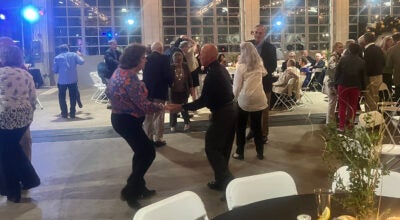Walter Miller is 1 of 7 in his family who served in WWII
Published 12:00 am Tuesday, September 27, 2011
CHINA GROVE — Walter Miller is a tough ol’ bird. Approaching 90 and a veteran of World War II, he owns a crushing steel grip, thanks to a career in construction and a retirement spent toiling away in his garden, which is more like a truck farm.
An Army sharpshooter, Miller remains pretty good with his rifle. Ask the scores of groundhogs he has picked off. Once he hit two with one shot.
He’s a morning person, who likes to eat breakfast every day at the Hardees in Kannapolis. Sometimes he’s waiting in the parking lot for the restaurant’s doors to open. Then it’s back home to the garden, which features peas as the dominant crop.
“He grows enough peas for the whole county,” daughter Sandra Miller complains.
Walter Miller carries a deep tan on his face, neck and arms and stays in miraculous condition for his age, even with a hip replacement when he was 82. “He’s about got a six-pack here,” Sandra says, pointing to her father’s stomach.
“Hard work,” Walter explains. “I’ve worked hard all my life.”
When it’s time to reminisce, Miller pulls up to the kitchen table and embraces a strong cup of coffee. He can talk the ears off a billy goat.
During World War II, Walter Miller’s family made sacrifices for the country with room to spare. Six Miller brothers and their only sister, Bernice, served in the war at the same time.
“I’m just amazed they all came back,” Sandra Miller says.
Roy Miller, a seaman first class, received crippling injuries in the war when he was wounded off the coast of Africa. Walter Miller was in small-arms training in Aberdeen, Md., when he heard that his injured brother had been shipped to a naval hospital in Charleston, S.C.
“I said, ‘I’m going to see my brother,’” Walter recalls, and he left the training school immediately. When he visited Roy for the first time, only his eyes and nose were visible through the cast.
Carl Miller, another brother, came down with malaria during his stint in Army. “He stayed sick for a long time before he got straightened out,” Walter says.
For the record, four of the Miller brothers were in the Navy: Roy and Albert and twins Harold and Herman.
Walter and Carl Miller served in the Army, and Bernice joined the Women’s Army Corps in 1943. Only brother Ray didn’t qualify for service.
Bernice, the oldest, waited until all of her brothers were either drafted or enlisted and gone from southern Rowan County until she left, too. She later married and moved to California.
Walter was always amazed that the twins, Harold and Herman, somehow stayed together throughout the war from boot camp through every assignment after that.
“I can’t believe it,” Walter says. “It wasn’t supposed to be that way.”
Herman, now deceased, stayed in the Navy and made it a career. Harold Miller lives today in Troutman.
Walter Miller resides off Patterson Road in the home place of his late stepmother. He entered the Army in August 1942. After several different training stops in the states, he boarded a transport ship to England, landing at a heavily damaged port hit hard by the Germans.
“I don’t know how we got that ship in there,” he says. “We didn’t take it (the war) too seriously until that. It sent cold chills up your spine.”
Miller would eventually cross the English channel and land in France with his ordnance company at Omaha Beach, spending two days and nights on the sand before heading for the harbor of Le Havre, the most severely damaged French city of the war.
As British and American troops pursued Germans across France, Le Havre became a base from which to supply the armies with men and equipment.
American camps around Le Havre were staging areas called cigarette camps and assembly areas called city camps.
Incoming units would pass through cigarette camps such as Chesterfield, Lucky Strike and Pall Mall on their way to city camps such as Atlanta, Baltimore and New York, on their way to the front.
Many U.S. veterans remember (not fondly) spending time at cigarette camps before the onset of the Battle of the Bulge.
Miller, who could drive anything, volunteered to drive supplies toward the front lines. It was treacherous duty, and he often was leading convoys to the assembly areas.
“There was no easy route, I want to tell you,” he remembers. “I said if my time’s coming, it’s coming.”
His trucks sported some bullet holes, and with the heavy artillery being fired “you had to hold onto your hat so it wouldn’t fall off,” but Miller emerged from the campaign across France without a scrape.
He remembers being in a cigarette camp at the end of the war in Europe and making his way back to Le Havre, thinking he and his buddies would be deployed next to the Pacific Theater.
He already was on the ship at Le Havre, destined for a new assignment, when the announcement came that the Japanese had surrendered.
“I said, ‘Man alive, I can’t believe this.’” Miller says of his good fortune.
There was quite a party. Local shopkeepers opened their doors and put all their goods on the street to celebrate with the Americans, he says.
At war’s end, all the city and cigarette camps were devoted to departures, and many of those camps processed liberated American prisoners of war and held German POWs. Nearly 3 million American troops, Walter Miller among them, entered or left Europe through Le Havre, making it known as the “Gateway to America” in 1945-46.
“I never was so happy as when the war was over in the Pacific,” Miller says.
Walter Miller would marry Irene Bogan, a girl he met while in boot camp at Camp Croft, S.C. After the war, Miller says, “I mostly looked for work.”
Before he enlisted, he had been employed at Cannon Mills, but when they returned stateside, he and brother Albert worked for awhile for Streamline Tool Co. in Conover.
Walter eventually returned to Rowan County, became a carpenter and worked for construction companies for decades to come, using the old farm off Patterson Road as a home base.
He was a carpenter on every building on the Salisbury VA Medical Center campus except for Building 18, he says. He also was part of heavy construction crews that built the NCNB building in Charlotte, the WBTV station and numerous public schools in the region.
Walter and Irene Miller would have two boys (both deceased) and two girls. Irene died in 1993.
Interestingly, Walter’s parents, David A. and Addie Mae Stewart Miller, had eight children, including the seven who served in the military during World War II. Walter’s mother died when he was 5, and his father remarried and had seven more children — two boys and five girls.
Sandra Miller lives today with her robust father, Walter, who has three grandchildren and four great-grandchildren. Their dog, Klondike, is also like one of the family.
Sandra says Walter is good with machinery and an inventor of sorts, making things he needs for their 5-acre spread.
With the garden, they do a lot of canning, freezing and giving away of vegetables, especially the peas, which Walter likes to run through his sheller by the gallon full.
“I’m an outside person,” Walter Miller says.
You don’t have to tell that to the groundhogs.
Contact Mark Wineka at 704-797-4263, or mwineka@salisburypost.com




